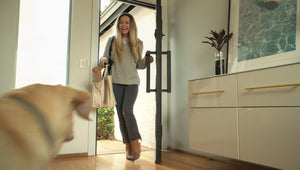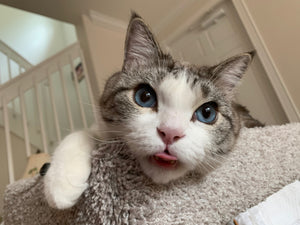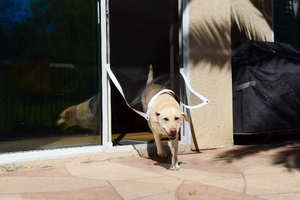How to Train Your Cat to Use the Cat Door
Most cats can be trained to use their cat flap; however, some cats have an easier time with it than others. If your feline friend is having trouble learning how to use their cat flap, then this is the article for you.
Cat Doors are a great addition to any home with an adventurous pet. If you want to give your cat access to a secure backyard or catio, a cat flap is the best way to give them freedom and space. Plus, cat flaps can be installed anywhere from your door or wall to your window or sliding glass door. There are plenty of options for every cat household. Usually, it’s getting your cat to use their door that most cat lovers encounter problems.
Whether your cat refuses to use their flap or is scared of it, this article will give you the tips you need to train your cat in how to use their brand new pet flap.

How to Teach Your Cat How to Use the Cat Flap
Many pet owners install their cat door without realizing that their cat may have never seen or one before. There are many steps you can take during your cat’s training to help them fall in love with their flap.
Introduce Your Cat To Their New Door
Change is always hard, so this tip is great for making a big change less stressful for your feline. Before installing your cat door, try giving your cat an opportunity to explore their new door on their own terms. Start by taking the door out of its box a few days before installing. Then, just leave it there! Your cat can now take their time examining their new door as much as they need.
Plus, if you have an electronic cat door like the Sureflap Microchip Cat Door, you can spend this time registering your cat’s microchip into the door’s system. Check out the SureFlap Connect collection for some great electronic options.
Add Your Cat’s Scent
If you have already installed your cat door, it might be harder to give your cat enough time to get used to their new door. However, one of the quickest ways to make your cat realize that something is theirs is to add their scent. Try rubbing your cat in a towel, then wiping it all over the door. Your cat’s scent will transfer over to the door, marking it as a part of their territory. The cat flap will suddenly start smelling like theirs.

Leave the Flap Open
While training your cat, it is best practice to first leave the flap open for them. Doing so allows them to get used to the idea that there is a hole in your door, wall, or window that they can go through. This is also a great training tip for those with opaque or magnetic flaps.
Cats have an easier time getting through clear flaps, as they can see where they’re going. Training your cat to go through an open hole is the first step before training them to push through a solid block.
Magnetic flaps, like the Endura Flap Cat Door, are great for keeping your home well insulated, but the added resistance can make it hard for cats to push through their flaps. Leaving the flap open is great for starting your cat out with their new door. Afterwards, you can try removing the magnets and adding them back one by one until your cat is used to the resistance. You can also tape over the magnets to make them weaker, or have one corner of the flap magnetless entirely.
If your ca has trouble using flaps, they might better enjoy using a flap-less entrance like the PetSafe Cat Corridor Interior Pet Door.
Add a Cat Toy, Treat, or Herb
Sometimes, a little extra motivation does wonders for helping your cat get through their door. With the flap either opened or closed, stand on the other side of the door with their favorite treat or toy. Try luring them through, rewarding them with it every time they do it successfully.
“Cat herbs” can also work wonders here.
Certain herbs have enticing smells that all cats go wild for, such as cat germander, clary sage, valerian, and, of course, catnip. Try luring your cat through the cat door with a little bit of their favorite herb (and rewarding them with some afterwards).
Replace the Cat Flap Temporarily
If your cat really doesn’t like their new flap, you can take off the flap entirely. In its place, try installing a cloth or a sheet of cling wrap. Both are easier for your cat to push through while they are training to use their door.
Push Open the Door For Them
The entire point of getting a cat door is not having to open the door for your cat. However, some cats are visual learners. If you try pushing the flap open in front of your cat, they will see how the door works and will be more willing to try the cat door for themselves. Just make sure you’re not pushing the flap open for them forever. As much as you love your kitty, you don’t want to be their doorman!
Muffle Loud Noises
Some cat doors can be noisy, which can scare cats away from using their door. While there are no easy fixes for locking doors that are noisy when they unlock, you can add a bit of foam around the edge of the flap to make its closing way softer. If your flap has magnets on it, you can apply tape of cloth over the magnets to soften the noise as well.

Common Concerns For Cat Flap Training
Even with these tips, there are a lot of questions pet owners have when training their cat to use their new pet door. Luckily, we’ve answered the most common ones here.
How do I get my cat to use the microchip cat flap?
Microchip cat flaps are a great option for households with multiple cats. The sensor on the door detects the unique microchip on your cat’s neck, and the sensor will not unlock the flap until it knows your cat is there. While the timing might be a little tricky for first-time cats, training will not be any different from a regular cat door. It will get easier once your cat associates the clicking of the lock with using the door.
How long does it take for a cat to get used to a cat flap?
Depends on the cat. Some cats get it right away, while others need just a little bit more time. Either way, be patient with your feline friend as they get used to this new part of their home.
Why won't my cat use the cat flap?
Your cat might be scared of the flap, or they might not have realized they can go through it. The tips listed above will help with both of these problems. Your cat might also just not have a lot of interest in leaving their cozy home.
Why has my cat stopped using the cat flap?
If your cat started using the door but abruptly stopped, then they need more training. They need to be more than just aware that the flap takes them outside; your cat needs to see the cat flap as their best option.
If your cat has been a long time user but stopped, then the door might no longer be comfortable for them to use. Make sure there’s nothing on the door that might be hurting your cat, such as a broken flap or a stuck-out piece of plastic.
If your cat is older, the flap may no longer be in an easily accessible location. You will need to move it somewhere that’s easier on their old joints.

Can older cats learn to use a cat flap?
Yes, they can! It might even be good for them, as training is great enrichment for getting their minds working.
Is my cat afraid of the cat door?
They might be. Cats don’t like change, and many don’t like loud noises. A new cat door can do one or both of those things. Even if your cat is afraid of the door, our tips will help them overcome their fears to enjoy more freedom.
Cat flaps are a great option for enriching your cat’s life, as well as freeing you up from pesky doorman duties. If you are having trouble picking out the perfect cat door for you, check out these articles:





Hi John and Jane,
I’m sorry to hear you are having trouble teaching your cat to use the cat door. Please feel free to contact us at customerservice@petdoors.com or 1-800-826-2871 and we can brainstorm some new ideas!
Happy holidays!
Hi Isabell,
I think what your doing is exactly right and will help familiarize your cat with the pet door. You can also add in some positive reinforcement by giving him his favorite treat every time he comes in through the door.
Please feel free to contact us at customerservice@petdoors.com or 1-800-826-2871 if you have any questions!
Happy holidays!
Loved your article! I’m a mom of 6 cats and one of them is an elderly cat. Georgie is very slow, lazy and couldn’t figure out the new acrylic pet door we put on our back glass door!
All the others come and go freely to our backyard and Georgie be there: stand still in front of the door!
Before the flap door, we used to leave the glass door opened. But we live in Melbourne Australia and here most of days are cold even if has sun!
I open the flap door to Georgie and he pass through! But he didn’t figure out how to flap himself…. I always need to go there and open the flap door for he goes out or come back inside!
My husband believe because he is old! He is 13yo! We adopted him from the shelter when he was 10!
I think Georgie is smart! All my cats has microchiped feeders from Surefeed and he knows how to open, he knows which one is his bowl…
I will try your tips! The treat/toys didn’t work…
Thank you
I haven’t seen any advice about what to do while the cat is learning. Litter box? Open the human door? Both would seem to sabotage training. I don’t want to give in, but I don’t want to stress my cat either.
My cat knows how to go out, but has trouble coming in. I’m holding the door open with a small rod and will make the opening smaller each day till he knows how to open the door as long he sees the door open enough to understand that it will open. Is this a good way to try training him slowly and not traumatized him?
Are there any cat flap that allow the duration between reading the chip and unlocking and relocking to be extended? Or can you or anyone suggest a solution to this issue I’m having?
My cat uses her paw to open the flap and not her head. She will paw the door until it swings and then follow with her head. This means that most of the time the sensor picks up her chip and unlocks but locks again before she manages to paw push the door to swing open. Making it useless.
Any constructive suggestions or brands of catflap with longer activation times would be appreciated. I’ve been researching and can’t find any information to help me.
I have tried absolutely EVERYTHING humane and unfortunately cannot find a novel solution. All articles, and I’ve read them all, list essentially the same solutions which do not work with our 2 year old rag doll. I guess we wasted money and have to open the door as she must be hopeless.
I have an electronic dog door that both cat and dog use. It works great
Hi Vicki,
Unfortunately, most pet doors will make noise when they’re in use including electronic ones. Because it is a new door, your cat might just need more time to get used to it. Have you tried using treats to train her? Aside from that, you can also talk to a pet behavioralist to see if there are any other options.
Please feel free to reach out to us at customerservice@petdoors.com if you have any additional questions!
We have just bought the ‘sure pet care ’ brand for our cat, we’ve had it for 3 days now. Our cat is so scared of it , especially when I try to get her through it. She had a normal cat door before this one. But she really hates and doesn’t like this microchip door. The noise it makes when she goes through it , I’m really stuck as to how to get her to use it. I’ve tried putting her through it but that doesn’t help at all. She is very friendly with the two of us but hates other people who come to the house . The cat door she had before was fine as it had no noise. Please what can I do .